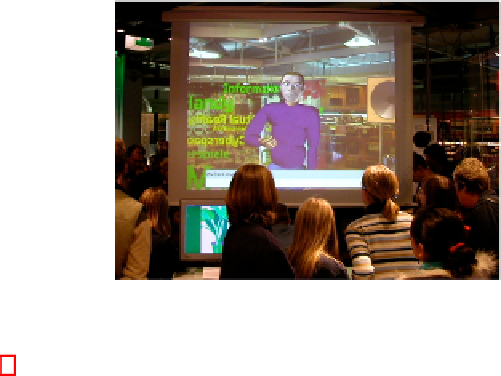Information Technology Reference
In-Depth Information
Fig. 3.
Max at the Heinz Nixdorf MuseumsForum in Paderborn, Germany
Figure 3 shows Max in his current state acting as a museum guide where he provides
information about the exhibition and involves human visitors in everyday small talks.
4.2
Max' Existing Dialog System
The agent's verbal communication is realized by a dialog system consisting of three
modules successively processing the input of the human dialog partner. In a first step
the interpreter of the dialog system determines the meaning of the user's input text.
The result of this analysis is then delivered to the dialog manager. By accessing the
dialog knowledge, the dialog manager chooses an according answer which is sent to
behavior planning afterwards. The behavior planning component translates the answer
into a multimodal utterance for the virtual character.
Both the interpretation of natural language inputs and the generation of an adequate
response to the user's utterance are based on a set of rules. Thereby the interpretation is
composed of two steps: First, the identification of modifiers specifying the expression
type such as negation, agreement, or greeting. Second, the identification of the con-
versational function reflecting the pragmatic and semantic meaning of the considered
utterance. These processes currently employ about 1.200 rule plans which are selected
and executed via pattern matching processes. These rules in turn direct the choice of an
adequate response.
Due to the rule-based input interpretation covering a broad spectrum of possible ut-
terances and an additional, Wikipedia-based question answering component [16], the
agent's system never fails in computing an appropriate reply. Hence, Max never stays
speechless even if an input cannot be decoded in detail. Nevertheless, the system has
not yet been able to establish coherent sequences of dialog contributions as human-
like topic awareness is not accessible for the agent. The integration of our online topic
detection model into the ECA's system architecture is twofold: First, we contribute to
improve human-agent conversations by enabling topical dialogs between human and ar-
tificial interlocutors. Second, the existing human-machine interface provides an optimal
platform for the evaluation of our approach.

